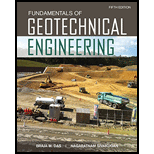
(a)
Find the maximum shear stress developed within the soil.
(a)
Answer to Problem 13.27CTP
The maximum shear stress developed within the soil is
Explanation of Solution
Given information:
The depth (H) of slope is 5 m.
The angle
The unit weight of the soil
The cohesion
The angle
Calculation:
The maximum shear stress developed at soil rock interface (5 m depth).
Find the maximum shear stress
Substitute
Thus, the maximum shear stress developed within the soil is
(b)
Find the maximum shear strength available within the soil.
(b)
Answer to Problem 13.27CTP
The maximum shear strength available within the soil is
Explanation of Solution
Given information:
The depth (H) of slope is 5 m.
The angle
The unit weight of the soil
The cohesion
The angle
Calculation:
Find the maximum shear strength
Substitute
Thus, the maximum shear strength available within the soil is
(c)
Find the factor of safety of the slope.
(c)
Answer to Problem 13.27CTP
The factor of safety of the slope is
Explanation of Solution
Given information:
The depth (H) of slope is 5 m.
The angle
The unit weight of the soil
The cohesion
The angle
Calculation:
Find the factor of safety
Substitute
Therefore, the factor of safety of the slope is
(d)
Find the maximum possible depth for the soil before it becomes unstable.
(d)
Answer to Problem 13.27CTP
The maximum possible depth for the soil before it becomes unstable is
Explanation of Solution
Given information:
The depth (H) of slope is 5 m.
The angle
The unit weight of the soil
The cohesion
The angle
Calculation:
The slope becomes unstable then the factor of safety
Find the maximum possible depth
Substitute
Thus, the maximum possible depth for the soil before it becomes unstable is
(e)
Find the factor of safety with respect to cohesion when the friction is fully mobilized.
(e)
Answer to Problem 13.27CTP
The factor of safety with respect to cohesion when the friction is fully mobilized is
Explanation of Solution
Given information:
The depth (H) of slope is 5 m.
The angle
The unit weight of the soil
The cohesion
The angle
Calculation:
The developed angle of friction is equal to the angle of friction when the friction is fully mobilized. Therefore,
Find the developed cohesion in the soil using the equation:
Substitute
Substitute
Find the factor of safety
Substitute
Thus, the factor of safety with respect to cohesion when the friction is fully mobilized is
Want to see more full solutions like this?
Chapter 13 Solutions
Fundamentals of Geotechnical Engineering (MindTap Course List)
- Given an infinite slope with the following properties: γ = 17 kN/m3, H = 5 m, β = 34°, φ = 25° and c = 20 kPa. a. Determine the normal stress. b. Determine the shear stress. c. Determine the factor of safety.arrow_forwardAn infinite slope consists of bed rock inclined at 15° to the horizontal that is covered by 4 m (measured vertically) soil with ?′=10?N/?2, ?′=24° and ?=19.0?N/?3.a. What is the factor of safety of this slope?b. If there is steady state seepage through the soil, with the water table coinciding with the ground level, what would be the factor of safety? Assume ?sat = 19.0?N/?3.arrow_forwardA 10m deep slope of 40° is made in a saturated clay of unit weight 20kN/m3. The value of cohesion is given as 72 kN/m2 and the Taylor's stability coefficient is given as 0.18. Compute the factor of safety for the load.arrow_forward
- For the infinite slope shown in Figure 15.46, determine the height, H, for critical equilibrium. Given: β = 27°, γ = 19.5 kN/m3, ϕ′ = 18°, and c′ = 35.9 kN/m3.arrow_forwardA long slope is made up of a cohesionless soil with the internal friction angle of 34°. If the water table rises to the surface of the slope, then determine the maximum possible value of the slope angle to get a factor of safety of 1.5. Take saturated unit weight as 18 kN/m3 and the unit weight of water as 10 kN/m3.arrow_forwardQ9.1 - A 25-m high rock cut with a face angle of 60° has been excavated in a massive, very weak volcanic tuff. A tension crack has opened behind the crest and it is likely that the slope is on the point of failure, that is, the factor of safety is approx imately 1.0. The friction angle of the material is estimated to be 35°, its density is 25kN / (m ^ 3) and the position of the water table is shown on the sketch of the slope (Figure 4). The rock contains no continuous joints dipping out of the face, and the most likely type of failure mode is circular failure. Required- (a) Carry out a back analysis of the failure to determine the limiting value of the cohesion when the factor of safety is 1.0. (b) Using the strength parameters calculated in (a), determine the factor of safety for a completely drained slope. Would drainage of the slope be a feasible method of stabilization? (c) Using the ground water level shown in Figure 4 and the strength parameters calculated in (a), calculate the…arrow_forward
 Fundamentals of Geotechnical Engineering (MindTap...Civil EngineeringISBN:9781305635180Author:Braja M. Das, Nagaratnam SivakuganPublisher:Cengage Learning
Fundamentals of Geotechnical Engineering (MindTap...Civil EngineeringISBN:9781305635180Author:Braja M. Das, Nagaratnam SivakuganPublisher:Cengage Learning Principles of Geotechnical Engineering (MindTap C...Civil EngineeringISBN:9781305970939Author:Braja M. Das, Khaled SobhanPublisher:Cengage Learning
Principles of Geotechnical Engineering (MindTap C...Civil EngineeringISBN:9781305970939Author:Braja M. Das, Khaled SobhanPublisher:Cengage Learning

